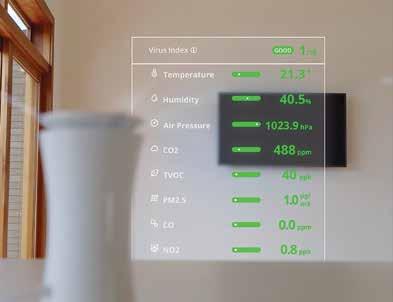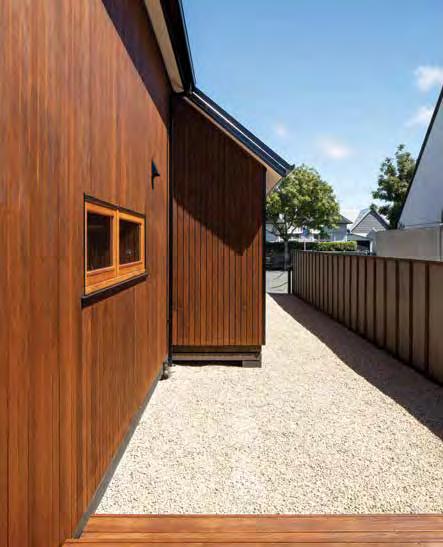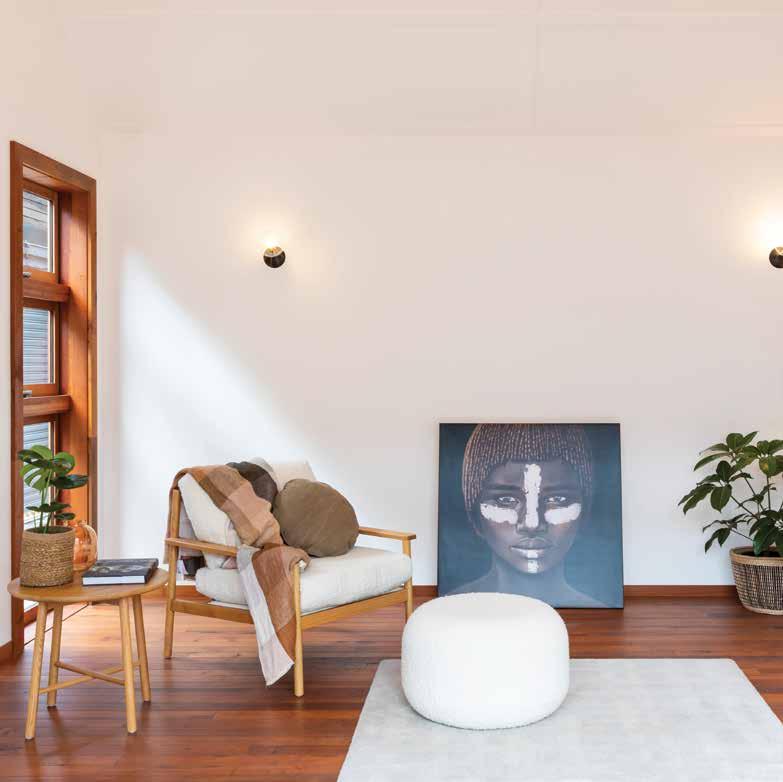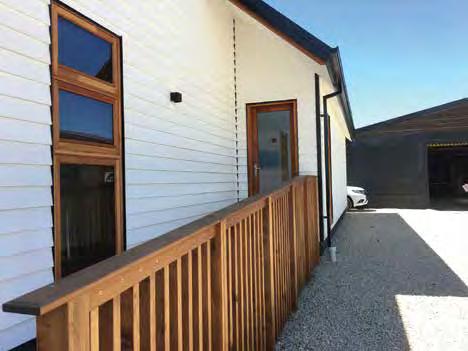
6 minute read
D ETOXIFY YOUR AIR
Foreverbreathe demonstration home at 1062 Columbo Street, Christchurch.
DETOXIFY YOUR AIR

MANY OF US USE TECHNOLOGY TO MONITOR OUR WELLBEING, FROM WHAT WE EAT TO HOW MUCH WE EXERCISE. THE NEW UHOO ALLOWS US TO TAKE CONTROL OF OUR HEALTH BY MONITORING UNSEEN TOXINS IN THE AIR.
The data from the uHoo monitor is empowering and beneficial for anyone maintaining a healthy lifestyle.
We like to know what’s in the food we eat, to understand any health risks involved with what we put into our bodies. In much the same way, it’s helpful to be aware of the air quality in our homes. As with food, the air in our environment isn’t always good for us.
The uHoo data capture monitor from the Foreverbreathe Demonstration Home showing an ideal reading where all levels appear in green.
WHAT DOES THE UHOO MEASURE AND WHY?
VIRUS INDEX The uHoo uses the power of air quality data to help you understand how the air in your home could impact your health and immune system with data that can be transformed into actionable insights.
TEMPERATURE This is measured to ensure the optimal range is maintained for people to feel comfortable while awake or asleep.
HUMIDITY Humans depend on humidity for perspiration to regulate their body temperatures, but high humidity affects this process, reducing moisture evaporation from the skin. The amount of water vapour in the air is also the primary factor for the development of moulds.
AIR PRESSURE High air pressure or stagnant air can cause headaches and migraines and even affect blood pressure. Those with joint pain can experience arthritis flare-ups. The increased pressure can also affect the inner ear canal, which can affect the sense of balance.

CARBON DIOXIDE (CO 2) Emitted by humans through the breathing process, it can also be created through various forms of combustion such as cooking and the use of cars. Too much CO2 can cause headaches, drowsiness, restlessness, lowered productivity and illness.
OZONE (O 3 ) High levels may increase the risk of getting certain lung diseases and lung damage. They can trigger various health problems, particularly for children, the elderly, and people of all ages with lung diseases such as asthma. DUST High levels of dust can cause significant aggravation to heart and lung function and can even lead to premature mortality among elderly people or those with cardiopulmonary diseases.

VOLATILE ORGANIC COMPOUNDS (VOC s) Vapour or gas from organic compounds is emitted from furniture and linens, office equipment, aerosol sprays, chemical cleaners, disinfectants, paints, and solvents. Exposure to toxic VOCs can cause headaches, nausea, dizziness, and irritation of the respiratory tract and eyes. Long-term exposure can cause liver damage, kidney damage and cancer.
CARBON MONOXIDE (CO) This highly toxic indoor air contaminant is a by-product of the combustion of fossil fuels, and common sources include tobacco smoke, heaters that use fossil fuels, central heating furnaces and cars. Symptoms start with headaches, fatigue, and nausea. At high levels it can cause disorientation, and those with heart conditions may begin experiencing chest pains.
NITROGEN DIOXIDE (NO 2) NO2 is found in vehicle exhausts and the fumes from burning fossil fuels such as propane, kerosene, natural gas and wood. In high concentrations, it can irritate airways in the human respiratory system. Long-term exposure can result in chronic illness and respiratory infections.

IS YOUR AIR TOXIC? THESE COULD BE SYMPTOMS:
q regular headaches q drowsiness during the day q lack of concentration q dizziness q sore or dry throat q a persistent cough that lasts for months q asthma q dry and sore skin q sore and itchy eyes q earache
q nausea q chest pain q chest infection q blocked nose q joint pain q high blood pressure

Health Based Building co-founders Robin Curtis and Casey Thomson are at the forefront of clean air building in New Zealand and have met many people looking for a healthier way to build after suffering from health problems in their homes. Robin says, “the decisionmaking process when purchasing a home is commonly not inclusive of air quality”. Health Based Building developed the Foreverbreathe Specification to ensure homes do not include building materials that impact human health. Health Based Building considers proof of performance claims a very important inclusion to have in the building industry hence the Foreverbreathe Specification is inclusive of monitoring and data capture using the uHoo system.

6 SMALL WAYS TO IMPROVE THE AIR QUALITY IN YOUR HOME
Z Open windows for 20 minutes every day to bring in fresh air and reduce CO2. Z Bring plants into your home to reduce the effects of VOCs. Z Leave internal access doors from garages closed until the fumes subside. Z Use a dehumidifier to reduce mould and virus-spreading moisture from the air. Z Where possible, buy natural or permeable home furnishings, especially bedding. Z Dust and vacuum often.
Several years ago, Natalie, a health professional, came to them after having to leave a newly built home when she developed a range of debilitating symptoms. Within one week of moving in, Natalie experienced pain in her stomach, liver and kidneys. She had developed sore, dry skin with facial bleeding. Her airways were inflamed, she felt anxiety at a physical level, and suffered from earache, insomnia and poor concentration. Natalie soon realised that this was due to exposure to toxins in her new home. After investigating the building materials used, she found that the internal walls used a grade of timber treatment recommended for outdoor use. It was a treated material that contained pesticides.
“It wasn’t surprising to find that pesticides, which are developed to attack the respiratory system and nervous system of insects, are also harmful to humans,” says Natalie, who was shocked by the lack of regulation in the building industry. “There needs to be a minimum standard for air quality, not just structural quality,” she says. Natalie held onto the property and moved in with family.
Robin and Casey encouraged her to take charge of her environment with a uHoo monitor, and she decided to try the uHoo in her workplace. “I’d recommend a uHoo to anyone,” says Natalie. “Before I had the uHoo, I thought that I was just very tired every day. It wasn’t until I was able to monitor the levels of toxins in the air that I realised that CO2 was making me drowsy.” Natalie was able to minimise the CO2 levels by opening a window for just a few minutes each day.
After living out of her toxic home for nearly two years, Natalie set up the uHoo for four months and was disappointed to find that VOC levels were still in the red. Natalie has since moved on from the home but has remained highly sensitive to VOCs ever since. She is currently working with Robin and Casey on building a new home using the Foreverbreathe Specification.










